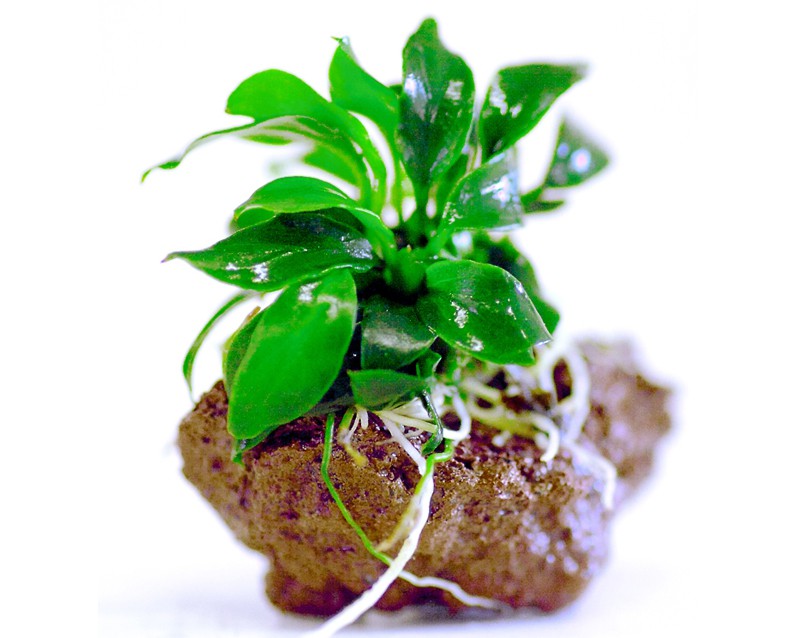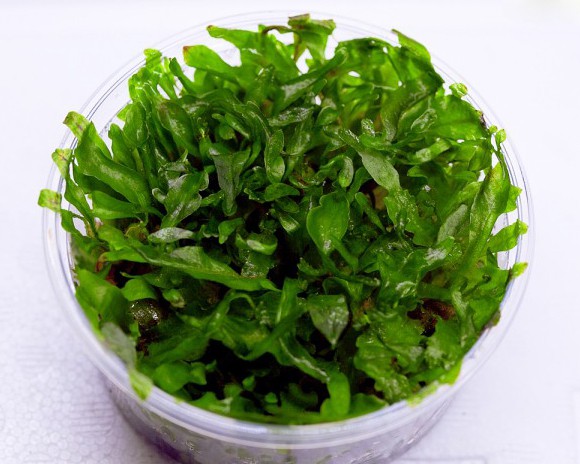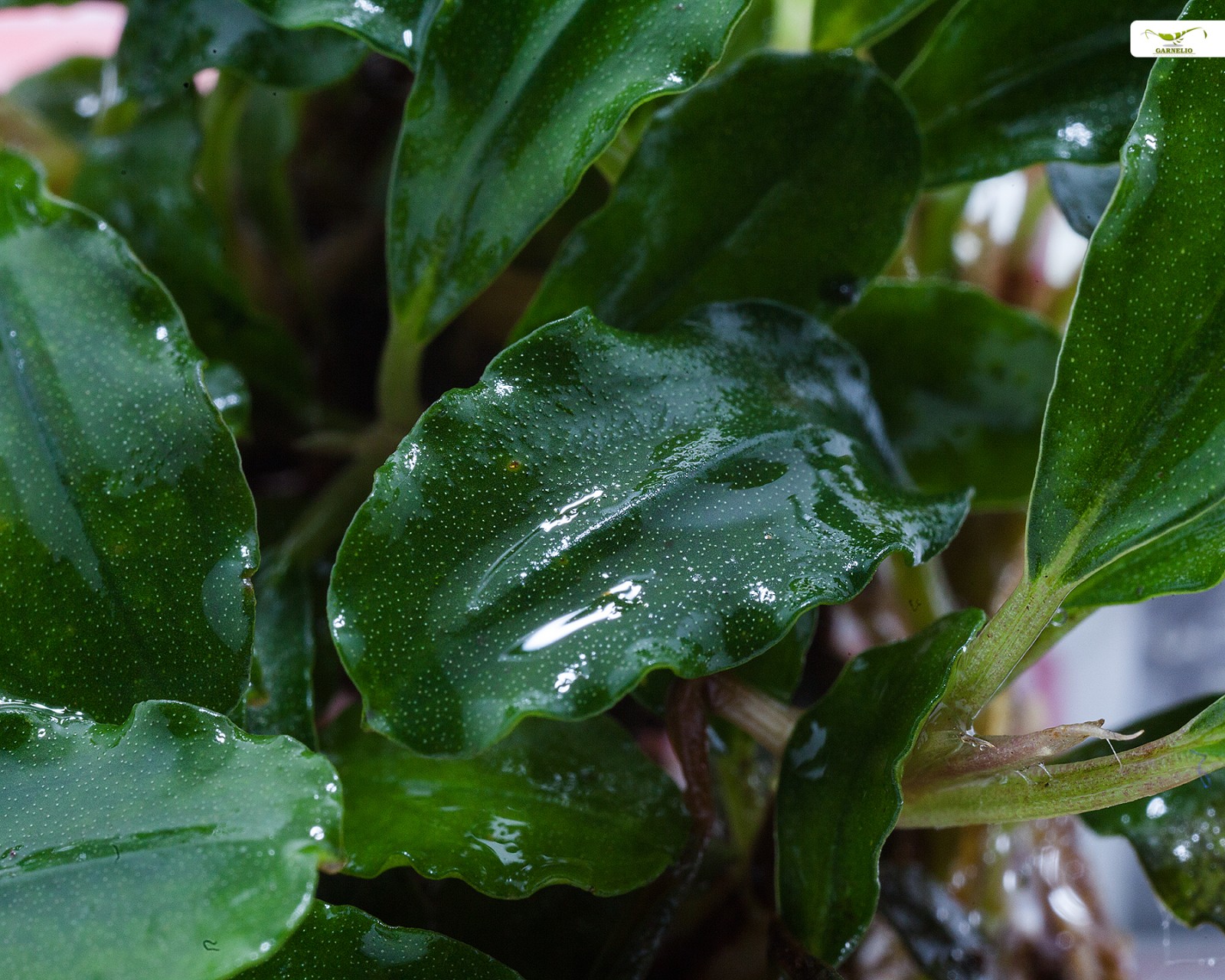The basics of aquarium plants: Middle ground plants, sitting on decoration
In aquariums decorated with aquarium roots and stones, this aquarium decoration is often placed in the middle ground. Here you can use special forms of the middle ground plants: The perching plants, which can be used for greening this decoration. They can be attached to roots and stones, i.e. the hardscape, as well as planted in the substrate.
Fixing the plants on the hardscape
The plants that are to be cultivated on the hardscape are tied to the aquarium roots and rocks with a nylon thread or cotton twine similar to moss, or they are glued with a non-toxic cyanoacrylate-based superglue. Over time, the roots of the epiphytes take root on the solid substrate and the plants continue to grow on the hardscape.
Planting epiphytes
If you prefer to plant the plants in the classical way, you have to be careful especially with plants with a thick rootstock (rhizome): The rhizome can start to rot in the substrate, for this reason you should carefully pull the plant out of the substrate after planting so that the thicker green rhizome lies above the gravel, sand or aquarium soil and only the finer lateral roots remain in the soil.
Anubias(store here)
Spear leaves from Africa are classic perching plants. In nature they grow partly emersed above water in the splash zone of waterfalls and fast flowing waters. Anubias are shade plants that can get by with little light in the aquarium and can even sit in the shade of decoration or tall or flooding aquatic plants in the background. They can flower under water. Anubias grow quite slowly and do not need to be cut back often. Anubias have exceptionally hard foliage and also taste bitter, so they are not nibbled by fish or crayfish and are therefore considered perch resistant.

Anubias toxic for shrimps?
In early publications you can read that Anubias can release toxic substances for shrimps when pruned back - this is now considered disproved, but the rumor persists. Tests with mashed Anubias and shrimp have shown that even this highly concentrated form does not harm the shrimp. If you still want to be on the safe side, you can simply remove the anubias from the aquarium for pruning. This usually works quite well with mounted specimens.
Propagation of Anubias
Anubias are propagated by division - simply cut off a piece of the rhizome with sharp scissors. There should still be at least two leaves on each section.
Anubias do not have any special requirements regarding water values and temperature. They can live just as well in unheated aquariums as in heated tanks up to about 30 °C.

Popular Anubias species
Popular spear leaves are for example Anubias barteri, Anubias gracilis, Anubias barteri var. nana, their little sister Anubias barteri var. nana "Bonsai" and also the variegated varieties Anubias barteri var. nana "Pinto" or "Gold". They are available from very small (5 cm height) to very large (up to 50 cm height). With Anubias, you can really find the right species or variety for every aquarium.
We have presented the most popular species and their exact needs in detail in our article"Anubias Plants in Aquarium / Terrarium - Species & Care" . By the way, Anubias also cut a really good figure in the terrarium!
Ferns
Ferns are also popular aquarium plants for hardscape decoration. As classic perching plants they also have a rhizome and should therefore not be completely buried when planting. They are propagated - like Anubias - by dividing the rhizome, some species also sprout offshoots at the leaf tips, the so-called filicles.
Congo fern - Bolbitis heudelotii(here to the store)
One of the most impressive water ferns for the aquarium is Bolbitis heudelotii, the Congo water fern from Africa. The slow growing plant tolerates even deep shade, but even brightly lit aquariums do not cause it any problems. It grows up to 40 cm high and with time impressively wide, so the river fern from Africa is rather something for large aquariums. The beautifully shaped dark green leaves contrast wonderfully with lighter aquarium plants. The Congo fern is also excellent as a solitary. CO2 fertilization is not necessary. The Congo fern can be cultivated at water temperatures of 18 to 27 degrees. Soft to medium hard water is optimal.

Mini Bolbitis - Bolbitis heteroclita "difformis"
This small growing fern species is a dwarf form of Bolbitis heteroclita and comes from tropical Asia. It fits very well in nano aquariums and on finely branched hardscape in larger tanks. It grows extremely slowly underwater, with coarsely pinnate short leaves. Water temperatures of 18-30 degrees and little to much light are well tolerated. However, the Mini Bolbitis feels really well rather emers - in the waterfall aquarium on the land part or in a humid terrarium or paludarium it comes optimally to the validity.
Java fern - Microsorum pteropus(here to the store)
A classic for the middle ground in the aquarium is the medium green to moss green java fern Microsorum pteropus from Asia. It gets along very well with little to much light and grows slowly. Java fern is considered a perch-resistant plant because the hard leaves taste quite bitter. It reproduces by means of filaments that grow at the tips of the leaves and detach themselves when they reach a certain size; in addition, java ferns can form spores. In the case of iron deficiency, brown to black spots appear on the leaves, in more extreme cases the leaves also turn completely brown and die. Here you should counteract early with a complete iron fertilizer. Javafarn can also grow excellently above water and fits perfectly in a wet terrarium or also in one of the popular waterfall aquariums.

There are different varieties of java fern:
The "normal" java fern Microsorum pteropus has leaves 2-3 cm wide and 10-20 cm long, ending in a point, which grow individually on the rhizome.
In contrast, the leaves of the narrow-leaved java fern (Microsorum pteropus "Narrow) are ribbon-like, only 1-2 cm wide and grow up to 25 cm long.
The Windelov java fern is named after the founder of the Tropica company, Holger Windeløv. At the top of the broad leaves sit antler-like fringes, which give the fern a beautiful fullness and look very apart. The leaves grow 2-3 cm wide and about 10-20 cm long.
Microsorum pteropus "Trident" also has very narrow leaves that divide into three to five parts at the base of the leaf. They grow to about 15 cm long, so this variety remains somewhat smaller than the other java fern varieties.
The Philippine Javafarn Microsorum pteropus "Philippine" has a hammered, particularly beautifully structured leaf surface, which only grows to about 2 cm wide. The leaves also grow to about 15-20 cm long. This variety is particularly suitable for hard water and can even grow in brackish water.
The variety "Petite" (Microsorum pteropus "Petite") remains particularly small. Here particularly small remaining plants were selectively propagated in the laboratory. With only 5-7 cm leaf length this variety fits beautifully in nano aquariums.
Bucephalandra(here to the store)
The still quite new Bucephalandra motleyana and Bucephalandra sp. originate from Indonesia. These great aquarium plants are also perfect for mounting in the middle ground, because they also like to grow in nature on stones and driftwood at the water's edge in the splash zone. Bucephalandra grow slowly, they captivate with different leaf sizes and shapes and with unbelievably intense leaf colors from rust red to blue green - often the shoots have a different color than the older leaves - and they are conceivably undemanding and easy to cultivate. There are many different varieties of Bucephalandra in circulation, which collectors like to display in aquariums set up especially for their Bucen. What they all have in common is that while CO2 is beneficial to growth, additional CO2 fertilization is not necessarily needed, they can get by with low to high light, they can flower underwater, and they grow best in soft to medium hard water.
Pinnate Water Lily - Hygrophila pinnatifida
One of the very few non-green perennials for the hardscape is the pinnate water friend from India. The very ornamental looking underwater leaves of this beautiful dark brown-red plant have a wine-red underside and are deeply incised and lobed. This special 5-40 cm tall perching plant looks beautiful in the aquarium, for example, together with mosses or smaller green plants. It reproduces by runners. The water should be soft to medium hard and 18-28 °C. The pinnate water-lily needs a little more light than the other typical perching plants, we recommend a medium to high light intensity. Also growing out of the water or emersed in a waterfall aquarium or on the land part of your paludarium, this water friend species looks perfect.

